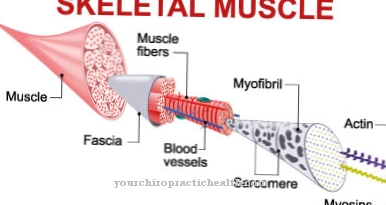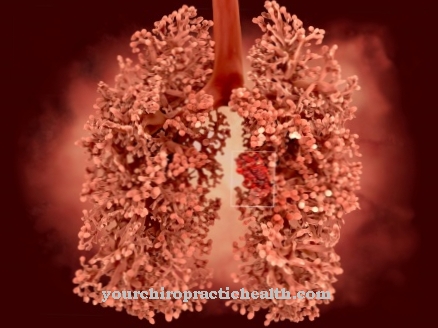Under one Gingival hyperplasia an overgrowth of the gums is understood. It is one of the periodontal diseases.
What is gingival hyperplasia?

© designua - stock.adobe.com
Gingival hyperplasia is gum overgrowth. It is assigned to the group of periodontal diseases (periodontal disease). The term gingival hyperplasia is made up of the Latin names "gingiva" (gums) and "hyperplasia" (excessive formation of cells). Another naming is Gingival hypertrophy.
However, the name is considered imprecise. The term hyperplasia refers to an increased number of cells.The term hypertrophy occurs in connection with an increased size of individual cells. Both factors can only be determined histologically. Gingival hyperplasia can occur locally on individual teeth as well as on the entire gum.
With a localized gum overgrowth, the growths take on the shape of a hemisphere. There is a connection to the gums through a tissue stem. Doctors also refer to this form as epulis. Gingival hyperplasia can also affect some breeds of dogs.
causes
The causes for the development of gingival hyperplasia are different. It is not uncommon for no specific cause for the gum overgrowth to be determined at all. In some cases it is also hereditary. In most cases, the use of certain medications is the cause of gingival hyperplasia. These are often preparations such as Cyclosporin A. This drug is used, among other things, in organ transplants.
Calcium channel blockers, which are released in the course of epilepsy, or phenytoin are also possible triggers. The overgrowth of the gums is then an undesirable side effect of long-term drug treatment. Other drugs that can be responsible for triggering gingival hyperplasia are nifedipine, valproate, and diltiazem. Nifedipine, phenytoin and cyclosporin A in particular have a pronounced affinity for the gingival connective tissue cells. As a result, they can be responsible for cell proliferation.
Another possible cause of gum growth are deficiency symptoms such as a lack of vitamin C or hormonal changes during pregnancy. Gingival hyperplasia is aggravated by inadequate dental hygiene, which leads to the formation of plaque. Inflammation and chemical or mechanical irritation can also be the cause of gum growths.
You can find your medication here
➔ Medicines against tartar and tooth discolorationSymptoms, ailments & signs
The extent of gingival hyperplasia varies from patient to patient. In addition to localized symptoms in individual teeth, symptoms in the entire gum are also possible. As a rule, however, the gingival hyperplasia is painless and appears as a rough growth on the tissue. The color of the gums varies between pink and dark red.
In some cases, patients have bleeding gums. Likewise, an ossification inside is possible. Gingival hyperplasia during pregnancy can also cause edema (water retention), bad breath and pain. With extensive gum growths, it is not uncommon for bite injuries to occur on the teeth of the opposite jaw.
A bacterial infection then threatens painful inflammation. Bleeding gums when brushing your teeth are also not uncommon. If the gingival hyperplasia is progestin or estrogen-induced, the growth is usually more extensive than if it is caused by phenytoin.
Diagnosis & course
An experienced dentist can usually diagnose gingival hyperplasia at first glance. To find out the cause of the gum overgrowth, the dentist conducts a survey of the patient. In addition, the extent of the periodontal disease is determined. A tissue examination using a microscope is also considered useful.
Idiopathic gingival hyperplasia, the cause of which cannot be clearly explained, progresses slowly. It can already occur in childhood or with mixed dentition. This creates the risk of problems with teeth erupting. If the growths are not treated dentally, it is possible that they cover the crown of the tooth.
In addition to negative aesthetic effects, disabilities and displacement phenomena in the dental area are also to be feared. If it is a question of gingival hyperplasia that was caused by taking medication, it usually goes away by itself when the offending drug is discontinued.
Complications
The complications and complaints of gingival hyperplasia are relatively different, but always lead to symptoms in the mouth area. This leads to extremely strong growths on the gums. This can change its color and usually turns dark red or pink. It is not uncommon for patients to suffer from profuse bleeding from the gums due to gingival hyperplasia.
An unpleasant halitosis also occurs. The gums themselves hurt and inflammation can develop on the teeth or on the root of the tooth itself. This inflammation also leads to severe pain and discomfort. The quality of life of the person affected is enormously restricted. Ordinary ingestion of food and fluids is no longer possible, so it is not uncommon for people to be underweight or dehydrated.
The inflammation in the mouth can also spread to other regions. The pain often spreads from the teeth to the head or ears and leads to unpleasant complaints in these areas as well. In most cases, gingival hyperplasia can be treated well. If there is inflammation, this can also be treated by a dentist. Life expectancy is not changed by the disease.
When should you go to the doctor?
If the person concerned suffers from swelling or growths in the mouth, a doctor should be consulted. When the gums change, there are often serious diseases that need to be examined and treated. If you experience pain in the mouth, abnormal gums or bleeding in the mouth, you should consult a doctor. If the gingival hyperplasia causes problems with existing dentures or existing tooth corrections, a doctor's visit is necessary.
If teeth loosen or teeth shift, a doctor's visit is required as soon as possible to avoid further complications. If there are changes in the vocalizations, lack of clarity in the language or if the person concerned refuses to speak due to the symptoms, a doctor should be consulted. If the symptoms increase, a doctor should be contacted immediately.
If you refuse to eat and drink there is a serious health risk. If the behavior leads to weight loss or a feeling of dryness inside the body, a doctor must be consulted immediately.
If bite wounds can be seen in the mouth or felt with the tongue, this is a worrying condition. Consultation with a doctor is necessary to clarify the cause. The formation of an unpleasant bad breath is considered a natural warning that should be investigated. Discoloration of the gums is also uncommon and should be checked by a doctor.
Doctors & therapists in your area
Treatment & Therapy
If the gingival hyperplasia does not resolve after stopping the drug or if it has other causes, treatment must be given by the dentist. Due to numerous relapses, the treatment of gum growths is a major challenge for dentists. Treatment can be conservative as well as surgical intervention.
The patient's oral hygiene plays an important role in non-surgical therapy. According to studies, a high standard of oral hygiene, which can be achieved through professional gum cleaning in addition to home care, can significantly reduce the risk of gingival hyperplasia. The aesthetics also benefit from it.
However, if medication has to be taken over the long term or if there is a severe case, an operation is required, during which the dentist removes the gum overgrowth with a scalpel. The patient receives a local anesthetic. The surgical removal of a gingival hyperplasia is called a gingivectomy in dentistry. The dentist cuts out part of the gums to correct the growth. The prognosis of gingival hyperplasia is generally considered to be positive.
Outlook & forecast
The prognosis of gingival hyperplasia is tied to the cause of the disorder. Basically, it is classified as favorable regardless of the causal disorder. If the bleeding from the gums is based on the administration of medicines, there is a quick prospect of relief from the symptoms.
As soon as the treatment plan is restructured, the drugs that cause gingival hyperplasia can be discontinued. Immediately afterwards, the symptoms regress until the symptoms are free. The underlying disease is treated with alternative drugs in these patients.
If the disease continues or if long-term therapy is necessary, a surgical procedure is carried out. A surgeon removes the growths of the gums. It is a routine procedure that takes place with the help of a local anesthetic. Although complications can occur, they are comparatively minor and only occur in exceptional cases. If the operation is successful, the patient will be free of symptoms after the surgical procedure.
Despite the favorable prognosis, the symptoms can return at any time in the course of life. The prospect of a cure is unchanged, even with renewed gum growth. If the gingival hyperplasia causes emotional problems due to the visual abnormalities, the risk of a psychological irregularity must be taken into account in the overall prognosis.
You can find your medication here
➔ Medicines against tartar and tooth discolorationprevention
To prevent gum growth from developing, dentists recommend regular thorough cleaning of the teeth. In this way, at least the extent of the gingival hyperplasia can be contained. If drugs are taken that are suspected of triggering gum overgrowth, the gums must be carefully monitored. The same is true during pregnancy.
Aftercare
In most cases, follow-up care for gingival hyperplasia proves to be relatively difficult. The patient is primarily dependent on medical treatment so that there are no further complications. However, the gingival hyperplasia can be treated relatively well, so that a reduced life expectancy is not to be expected. In most cases, the course of the disease is positive.
The earlier the symptoms are recognized, the better the further course of this disease. Gingival hyperplasia is usually treated by surgical intervention in the oral cavity. After such an operation, those affected should rest and take care of their bodies. The oral cavity in particular should be spared and not stressed.
In most cases, solid food cannot be consumed after the procedure, so the body should get used to the solid food over time. In some cases of gingival hyperplasia, a follow-up check is also necessary to detect and then treat new growths. Another intervention is necessary. Those affected should ensure that their gums are cleaned and that they maintain proper oral hygiene in general to prevent gingival hyperplasia.
You can do that yourself
If the gum growths are due to malnutrition as a result of a reduction diet, the most effective form of self-help is to take dietary supplements. Often gum growths are the result of a vitamin C deficit, which can most easily be compensated by taking ascorbic acid in powder form. Appropriate preparations can be bought over the counter in pharmacies and drugstores.
If the gingival hyperplasia is triggered by taking medications such as nifedipine or valproate, the attending physician should be consulted. It is important to clarify whether drugs are available that do not have the undesirable side effect.
The most common cause of gingival hyperplasia is poor oral hygiene. In this case, those affected should clean their teeth thoroughly with a soft brush and toothpaste after each meal. You have to brush for at least three minutes at least twice a day. The teeth cleaning in between can also be scarce, but all food residues should always be thoroughly removed.
The tongue must not be forgotten, on which bacterial coatings can form very quickly. The use of dental floss is also important. In addition, an antibacterial mouthwash can be helpful for gingival hyperplasia. In lengthy cases, regular professional cleaning of the teeth and gums by a dental hygienist is also indicated.
























.jpg)



